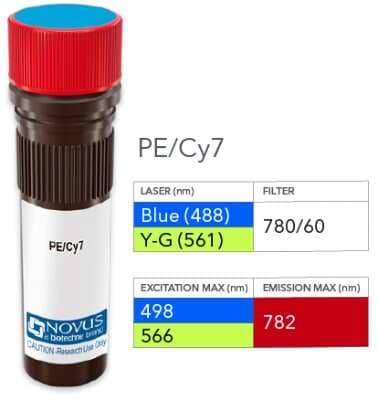CD4 Antibody (MT310) [PE/Cy7]
Novus Biologicals, part of Bio-Techne | Catalog # NBP2-52706PECY7
Recombinant Monoclonal Antibody. Clone MT310 was used by HLDA to establish CD designation.


Conjugate
Catalog #
Forumulation
Catalog #
Key Product Details
Species Reactivity
Human, Cynomolgus Monkey, Rhesus Macaque
Applications
Flow Cytometry, Product Image
Label
PE/Cy7 (Excitation = 488 nm, Emission = 778 nm)
Antibody Source
Recombinant Monoclonal Mouse IgG1 kappa Clone # MT310
Concentration
Please see the vial label for concentration. If unlisted please contact technical services.
Product Specifications
Immunogen
CD4
Reactivity Notes
Human, Rhesus Monkey, Cynomolgus Monkey
Specificity
mt310 binds to the extracellular domain D1 of CD4 -the same site as the HIV-1 gp120-binding site
Clonality
Monoclonal
Host
Mouse
Isotype
IgG1 kappa
Scientific Data Images for CD4 Antibody (MT310) [PE/Cy7]
Product Image: CD4 Antibody (MT310) [PE/Cy7] [NBP2-52706PECY7] - Vial of PE/Cy7 conjugated antibody. PE/Cy7 has two excitation maxima, 489 nm excited by the Blue laser (488 nm) and 566 nm excited by the Yellow-Green laser (561 nm). Both result in emission at 782 nm.
Applications for CD4 Antibody (MT310) [PE/Cy7]
Application
Recommended Usage
Flow Cytometry
Optimal dilutions of this antibody should be experimentally determined.
Product Image
Optimal dilutions of this antibody should be experimentally determined.
Application Notes
Optimal dilution of this antibody should be experimentally determined. For optimal results using our Tandem dyes, please avoid prolonged exposure to light or extreme temperature fluctuations. These can lead to irreversible degradation or decoupling. When staining intracellular targets, specific attention to the fixation and permeabilization steps in your flow protocol may be required. Please contact our technical support team at technical@novusbio.com if you have any questions.
Formulation, Preparation, and Storage
Purification
Protein A purified
Formulation
PBS
Preservative
0.05% Sodium Azide
Concentration
Please see the vial label for concentration. If unlisted please contact technical services.
Shipping
The product is shipped with polar packs. Upon receipt, store it immediately at the temperature recommended below.
Stability & Storage
Store at 4C in the dark. Do not freeze.
Background: CD4
Given its critical role in T cell development, CD4 also has diverse immunology-related functions. CD4 acts as a coreceptor with the T-cell receptor (TCR) during T cell activation and thymic differentiation by binding directly to major histocompatibility complex (MHC) class II antigens and associating with the protein tyrosine kinase, Lck (4). This interaction contributes to the formation of the immunological synapse (5). Defects in antigen presentation cause dysfunction of CD4+ T cells and the almost complete loss of MHC II expression on B cells in peripheral blood, as observed in severe combined immunodeficiency (SCID) (6). CD4 also functions as a receptor for the human immunodeficiency virus (HIV) by binding to gp120, the envelope glycoprotein of HIV-1. It has been shown that the V-like domains are critical for binding to gp120 (7). In immune mediated and infectious diseases of the central nervous system, CD4 functions as an indirect mediator of neuronal damage (8).
References
1. Omri, B., Crisanti, P., Alliot, F., Marty, M., Rutin, J., Levallois, C., . . . Pessac, B. (1994). CD4 expression in neurons of the central nervous system. International Immunology, 6(3), 377-385. doi:10.1093/intimm/6.3.377
2. Wan, Y. Y., & Flavell, R. A. (2009). How diverse-CD4 effector T cells and their functions. Journal of Molecular Cell Biology, 1(1), 20-36. doi:10.1093/jmcb/mjp001
3. Wu, H., Myszka, D. G., Tendian, S. W., Brouillette, C. G., Sweet, R. W., Chaiken, I. M., & Hendrickson, W. A. (1996). Kinetic and structural analysis of mutant CD4 receptors that are defective in HIV gp120 binding. Proceedings of the National Academy of Sciences, 93(26), 15030-15035. doi:10.1073/pnas.93.26.15030
4. Doyle, C., & Strominger, J. L. (1987). Interaction between CD4 and class II MHC molecules mediates cell adhesion. Nature, 330, 256-259. doi:10.1038/330256a0
5. Vignali, D. A. (2010). CD4 on the road to coreceptor status. The Journal of Immunology, 184(11), 5933-5934. doi:10.4049/jimmunol.1090037
6. Tasher, D., & Dalal, I. (2012). The genetic basis of severe combined immunodeficiency and its variants. The Application of Clinical Genetics, 5, 67-80. doi:10.2147/tacg.s18693
7. Arthos, J., Deen, K. C., Chaikin, M. A., Fornwald, J. A., Sathe, G., Sattentau, Q. J., . . . Sweet, R. W. (1989). Identification of the residues in human CD4 critical for the binding of HIV. Cell, 57(3), 469-481. doi:10.1016/0092-8674(89)90922-7
8. Buttini, M., Westland, C. E., Masliah, E., Yafeh, A. M., Wyss-Coray, T., Mucke, L. (1998). Novel role of human cd4 molecule identified in neurodegeneration. Nature Medicine, 4(4), 441-446. doi:10.1038/nm0498-441
Alternate Names
CD4
Gene Symbol
CD4
Additional CD4 Products
Product Documents for CD4 Antibody (MT310) [PE/Cy7]
Product Specific Notices for CD4 Antibody (MT310) [PE/Cy7]
This product is for research use only and is not approved for use in humans or in clinical diagnosis. Primary Antibodies are guaranteed for 1 year from date of receipt.
